Text
A quick observation for chapter 127
spoilers under the cut

Which twin is this? Probably Amane!
Amane tends to wear his bag on his left shoulder
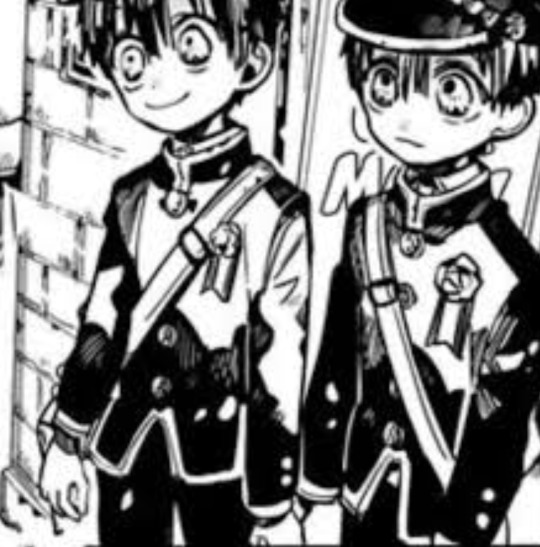


Now, this could be nothing, but AidaIro is known for throwing little clues like this into their manga. We'll see soon!
17 notes
·
View notes
Text
Toilet Bound Hanako-kun Hanakotoba Analysis

While it might seem surprising that it's taken me this long to cover TBHK—given my adoration of the series and its abundance of flower symbolism—what delayed me was mainly the lack of clarity as to which flowers represented which characters and scenes. This is mostly because multiple characters have been depicted with the same flowers while some characters have been depicted with multiple flowers. I went off of flowers I've seen in the anime and any official artwork I managed to find since it's been a while since I read the manga. In any case, I tried my best...
═══════════════════════
-> 1) Camellia (Camellia japonica)



-> 1.1) Flower Symbolism:
In Japan, camellias are called tsubaki (椿). They are associated with modest kindness, pride, eternal love and enduring love in hanakotoba. Red camellias in particular symbolise love, humble virtue, modest splendour, unpretentious grace and "perishing with grace" in hanakotoba. Pink camellias represent love, modesty, beauty, longing and missing someone. On the other hand, white camellias symbolise waiting, impeccable charm complete beauty and supreme loveliness. Camellias are also associated with everlasting love, marital bliss and perfect unions between lovers because, unlike most other flowers, the calyx and petals of a camellia flower don't separate when its flower wilts. In Western floriography, camellias are associated with constancy, steadfastness, perfect loveliness, unpretending excellence, adoration, longing, admiration and perfection. Red camellias in particular are associated with passion, love and desire.
-> 1.2) Discussion of symbolism:
The most prevalent flower depicted in the TBHK anime and manga series—as well as in its official artwork—is the red camellia. A silhouette of a camellia flower is even incorporated into the series' logo. In the series, camellias are often associated with its titular protagonist, Hanako—but are also occasionally associated with Nene Yashiro and Tsukasa Yugi. Despite being closed off and often smiling to mask his emotions, Hanako cares greatly for those close to him, which ties into the camellia's symbolism of modest kindness. Over the course of the series, Hanako and Nene have come to care a great deal for one another with the former going so far as to uproot the lives of others and sacrifice his own existence to save her. This ties into the camellia's symbolism of enduring love, adoration, longing, passion and perishing with grace. Meanwhile, Nene goes so far as to change the timeline so she can see him again. This ties into the camellia's association with steadfastness, longing, passion, adoration and enduring love. Nene's innate kindness and naivety as well as her development throughout the series from an insecure, hopeless romantic to someone more assured and determined greatly complements the flower's symbolism of loveliness, charm, modesty and beauty.
━━━━━━━━━━━━━━━━
-> 2) Hollyhock (Alcea rosea)


-> 2.1) Flower symbolism:
In Japan, hollyhock flowers are called tachiaoi (タチアオイ) and symbolise ambition, abundance as well as noble and majestic beauty in hanakotoba. Pink hollyhocks in particular symbolise benevolence and gentleness while red ones symbolise love. In Western floriography, hollyhocks are associated with ambition and fruitfulness. Pink hollyhocks represent innocence, youthfulness, gentleness and grace while red ones symbolise passion, love, strength, resilience and courage.
-> 2.2) Discussion of symbolism:
In the series' first episode, hollyhock flowers are seen growing in the garden that Nene tends to as she talks to Hanako. They are also pictured in the opening theme of the second season alongside Aoi Akane. Hollyhock flowers have also been depicted in official artwork alongside Nene and Hanako. The hollyhock flower's symbolism of strength, resilience, courage, and love complement the trials and tribulations Nene and Hanako have gone through for one another. While the flower's symbolism of benevolence, ambition, gentleness, youthfulness, resilience, passion and love strongly complement Nene's character. Although she isn't depicted with hollyhock flowers as often as HanaNene are, the kanji of Aoi's name (葵) translates to hollyhock. The hollyhock flower's symbolism of grace, passion, love, beauty, benevolence and gentleness complement her outward-facing personality.
━━━━━━━━━━━━━━━━
-> 3) Bellflower (Campanula sp.)


The flowers depicted in this artwork of Hanako and Nene Yashiro are bellflowers. Although the exact species depicted is unclear, the closest resemblance is the Korean bellflower (Campanula takesimana).
-> 3.1) Flower symbolism:
In Japan, bellflowers are called berufurawā (ベルフラワー) and represent humility, gratitude, sincerity and an unchanging heart in hanakotoba. The bellflower's association with humility is derived from its downfacing flowers. In Western floriography, bellflowers symbolise humility, constancy, sincerity, gratitude and unwavering love.
-> 3.2) Discussion of symbolism:
Pinkish-purple bellflowers are featured alongside Nene Yashiro and Hanako in the release notice and cover artwork of chapter 116 of the manga. The bellflower's associations with gratitude, sincerity, constancy, unwavering love and an unchanging heart greatly complement Hanako and Nene's feelings for one another.
━━━━━━━━━━━━━━━━
-> 4) Daffodil (Narcissus sp.) & Marigold (Tagetes sp.)


-> 4.1.) Flower symbolism:
-> 4.1.1) Daffodil Flower Symbolism:
In Japan, daffodils are known as suisen (水仙). They are associated with conceitedness, self-love, respect, regard and unrequited love in hanakotoba. Yellow daffodils in particular symbolise "come back to me" and "I want you to love me again". In Western floriography, daffodils symbolise egoism, self-love, respect, chivalry, unrequited love, evanescent happiness and deceitful hopes.
-> 4.1.2) Marigold Flower Symbolism:
In Japan, marigold flowers are called marīgōrudo (マリーゴールド). They represent jealousy, despair and sadness in hanakotoba. In Western floriography, marigolds symbolise jealousy, despair, cruelty, pain, pessimism and grief.
-> 4.2) Discussion of symbolism:
Daffodils and marigolds are featured on the cover of volume 15 of the cover as well as on the above official art of Hanako. Although the main trio is featured on the cover of volume 15 given the solo artwork of Hanako, it's a reasonable assumption that he is the one canonically linked with these flowers. A single daffodil is also featured on the cover of volume 0 alongside Hanako. Both daffodils and marigolds have negative connotations in flower language contrary to their bright and pretty appearance. This is somewhat reminiscent of how Hanako hides his true emotions and inner turmoil behind a mask of cheerful mischievousness and hides how closed off he is emotionally with Nene with how physically affectionate he is with her. Added to this, the marigold's symbolism of jealousy, despair and grief as well as the daffodil's symbolism of regard, egoism, deceitful hopes complement his character. Furthermore, the daffodil's symbolism of "come back to me" and "I want you to love me again" greatly resonates with Nene's feelings towards Hanako in the current arc of the manga.
━━━━━━━━━━━━━━━━
-> 5) Sunflower (Helianthus sp.) & White Lily (Lilium candidum) & Tiger Lily (Lilium lancifolium)


-> 5.1) Flower Symbolism:
-> 5.1.1) Sunflower Flower Symbolism:
In Japan, sunflowers are called himawari (ひまわり). In hanakotoba, they represent longing, adoration, aspiration and "I look only at you", longing, adoration". In Western floriography, sunflowers symbolise adoration, good luck, resilience, happiness, optimism, warmth, longevity and false riches. Sunflowers are also a representation of unconditional love, devotion and loyalty.
-> 5.1.2) White Lily Flower Symbolism:
In Japan, white lilies are called shirayuri (白百合). They symbolise purity, chastity, innocence and dignity in hanakotoba. In Western floriography, they symbolise affection, majesty, purity, sweetness and refined beauty. They are also associated with faith, rebirth and commitment. White lilies are often used at weddings due to their association with purity, commitment, and love. However, because of their association with purity, white lilies are often used at funerals and are thus also perceived as a symbol of grief and mourning. This established association of death with purity suggests that the departed spirit is pure, virtuous, and innocent, conveying sincere sentiments of hope and mercy beyond death.
-> 5.1.3) Tiger Lily Flower Symbolism:
In Japan, orange lilies symbolise brilliance and humour. In hanakotoba, Tiger lilies—which are called oniyuri (鬼百合)—represent pride, wisdom as well as wealth. In Western floriography, tiger lilies are associated with compassion, charity, wealth, humble pride, passion, mercy, confidence, positivity, prosperity and protection.
-> 5.2) Discussion of symbolism:
Tiger lilies and white lilies are featured on the volume 0 cover of the manga alongside Hanako. While sunflowers are depicted alongside Hanako on the cover of AidaIro's art collection. The sunflower's symbolism of adoration, longing, devotion, loyalty, unconditional love and "I only look at you" resonates with Hanako's feelings towards Nene. The sunflower's association with longevity and good fortune is reminiscent of Hanako's desire for Nene to live a good and long life. Given its association with positivity and happiness, the sunflower in the artwork could be a symbolic representation of Nene and how he longs for her and wants to protect her rather than just a figurative representation of his feelings towards her. The white lilies on the cover of volume 0 could be a representation of Hanako's purity and innocence during his human life as Amane Yugi. The white lilies' association with grief and mourning could infer that he mourns the loss of his innocence and purity. Conversely, the white lilies depicted could represent Nene while the tiger lilies represent Kou Minamoto—along with the daffodil representing Hanako. Each flower's symbolism complements their respective character, supporting this theory. With the white lily's association with purity, innocence, sweetness and beauty complementing Nene. While the tiger lily's symbolism of confidence, passion, positivity, charity, mercy, compassion and protection complements Kou.
━━━━━━━━━━━━━━━━
-> 6) Baby Blue Eyes (Nemophila sp.) & Lotus (Nelumbo nucifera)


-> 6.1) Flower Symbolism:
-> 6.1.1) Baby Blue Eye Flower Symbolism:
Baby Blue Eye flowers are known as Rurikarakusa (ルリカラクサ) in Japan. In hanakotoba, they symbolise success everywhere, daintiness and forgiveness. In Western floriography, they are associated with victory, prosperity, tenderness, sensitivity, harmony and trust. They also represent the transient nature of beauty and life, encouraging us to treasure every moment and appreciate simplicity.
-> 6.1.2) Lotus Flower Symbolism:
In Japan, lotuses are called ren (蓮) or hasu (はす). In hanakotoba, they symbolise eloquence, detached love, sacredness, and a pure heart. They are also associated with rebirth, purity, transformation, renewal, spiritual enlightenment and resurrection as well as beauty, grace and perfection. In Western floriography, lotuses symbolize purity of the heart, virtue, innocence, achieving great things, beauty rising from humble beginnings and bringing together separate things. Lotuses also symbolize estranged love and eloquence. Pink lotuses in particular are often associated with feelings of admiration.
-> 6.2) Discussion of symbolism:
Pink lotuses are depicted alongside Nene and Aoi on the cover of volume 13 of the manga. While the blue flowers depicted around Nene and Aoi on the artwork commemorating the release of chapter 60 are likely Baby Blue Eye (Nemophila) flowers. The lotus' representation of purity, enlightenment, innocence, virtue and sacredness is symbolic of both Nene and Aoi's roles as kannagi—ritual sacrifices to appease the gods and separate the far and near shores. The lotus' symbolism of perfection, beauty, grace and eloquence is reminiscent of how others perceive Aoi. Meanwhile, its symbolism of detached or estranged love is more reminiscent of her real personality and her feelings of resentment and bitterness at having to constantly pretend. The lotus' symbolism of a pure heart, admiration, "beauty rising from humble beginnings" and "bringing together separate things" complements Nene's character. The Nemophila's symbolism of harmony, trust, tenderness, sensitivity, forgiveness, success and treasuring simplicity complements Nene and Aoi's friendship and reinforces how all the tribulations they go through together strengthen their bond.
━━━━━━━━━━━━━━━━
-> 7) White Violet (Viola mandshurica) & White Daisy (Bellis perennis)


->7.1) Flower Symbolism:
->7.1.1) White Violet Flower Symbolism:
Violet flowers are called sumire (菫) in Japan. In hanakotoba, they represent humility, sincerity and small happiness. White violets in particular symbolise purity, candor and innocent love. In Western floriography, violets symbolise modesty and faithfulness. White violets in particular symbolise faithfulness, loyalty, modesty, innocence and purity.
-> 7.1.2) White Daisy Flower Symbolism:
In Japan. daisies are called hinagiku (雛菊). They represent purity, beauty, peace, innocence and hope in hanakotoba. In Western floriography, daisies symbolise purity, innocence, new beginnings and beauty.
-> 7.2) Discussion of symbolism:
On volume 18's fifth publication notice artwork, Sumire Akane is depicted alongside white daisies. While on the release artwork of chapter 89, she is depicted alongside white violets. Sumire's name (スミレ) means violet in Japanese making it a fitting choice for this artwork. The violet's association with modesty, innocence, purity, humility and sincerity plays into Sumire's youthful, nurturing and cheerful outward-facing persona. The artwork depicts her gently holding a white rabbit complementing this notion. The daisy's symbolism of peace, purity, innocence, beauty and hope further accentuates this. Although neither flower's symbolism hints at her underlying sadistic and manipulative side, her smile in each artwork is somewhat too saccharine. Both flowers' association with purity and innocence is symbolic of her role as a kannagi.
═══════════════════════
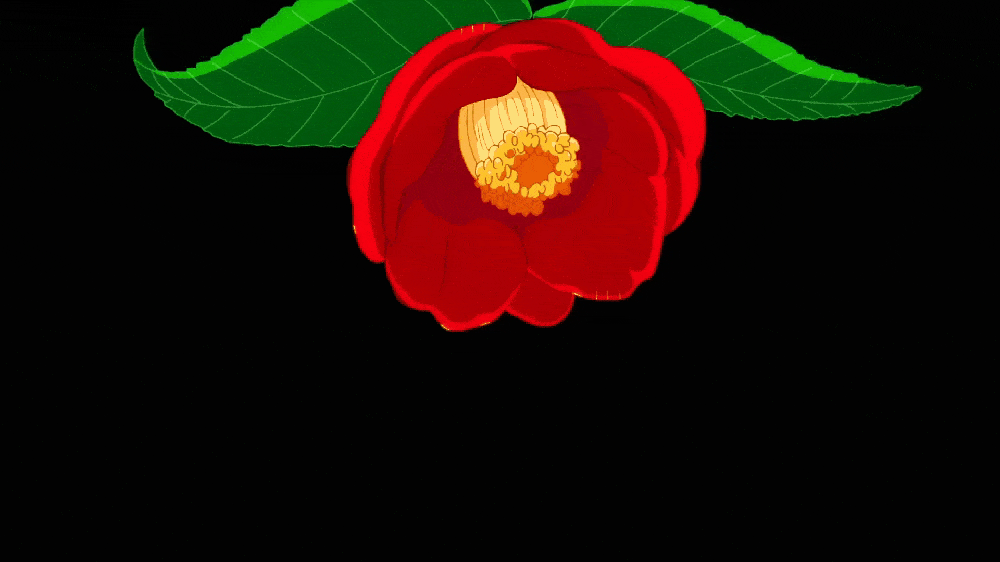
╰➤ Other anime & donghua hanakotoba posts
104 notes
·
View notes
Text
The sun and moon clock

Something I like to notice is that both clocks have standard designs, one has the sun and the other the moon.
Amane is represented by the sun and Tsukasa by the moon.

So, the reality of the sun would be Amane's reality, where he survived until he became an adult, the tentacled version of Amane.
The clock is under the stairs.

And what is under the stairs in this reality?

The reality of the moon is the one we followed, Tsukasa's reality, we see the torn books and Amane injured, about to jump off the stairs.

So...

So, the clocks represent the different realities? Interesting.
If none of these clocks lead to a good reality, what would be the ideal clock?
68 notes
·
View notes
Text


I would like to remind everyone just how funny Hanako being the phantom and teaching nene is, considering the fact that he’s canonically tone deaf!!😭😭😭🙏🙏
174 notes
·
View notes
Text

Season 2 poster.
Omen of the PP arc??? And look at the tag on his hand, WE WILL SEE LITTLE AMANE!!!!
252 notes
·
View notes
Text

quick low effort hananene yuri doodle for today
182 notes
·
View notes
Text
it’s like this arc has bits of prev arcs embedded in it,
picture perfect,





severance,






red house,






smth similar to the far shore arc soon??
705 notes
·
View notes
Text


Everybody welcome the Minamoto brothers!! One of them is on the brink of a break down and the other is Kou Minamoto!!/j
346 notes
·
View notes
Text
Kou never mistakes Hanako for a human, and I find that interesting.
He heard about Amane from Nene, who had front roll seats to his past and gained an intimate wake up call that "Hanako is not a 'magic being' from a fantasy book, he was a student, who is now dead"
His death is not a conflict for Kou though, is just who he is. What Nene shares isn't a revelation, he is well aware the ghost is dead, so he learns are small pieces of the puzzle that is Hanako, the understanding used to study here.

Kou has no real link to Amane, he never met the guy. Even when explicitly talking about Amane, Kou has no mental image of this 13-year-old who killed his own brother, he can only picture Hanako, the ghost.

Kou doesn't interact with 'Amane' in Picture Perfect either, the very few interactions they have are super short, and always started by Hanako in his Amane disguise.

And the one time Kou approaches him is because 'Amane' was carrying an unconscious Nene, so he gets curious, and shows that he doesn't trust him.
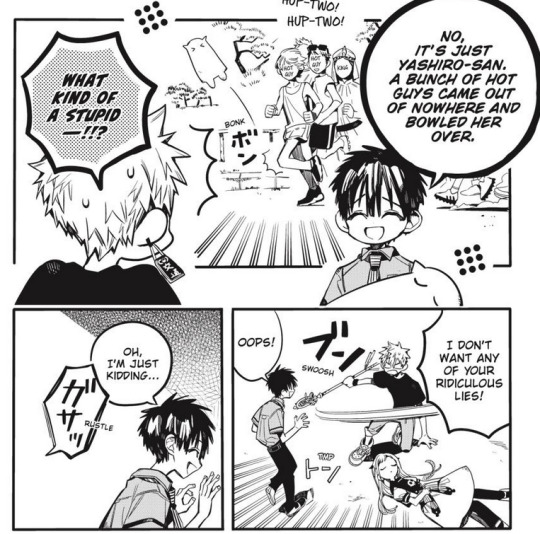
But when he learns it's Hanako, he is delighted. It doesn't matter that Mitsuba is acting weird, and that he still didn't get any answers, cause is Hanako! Hanako help him out!
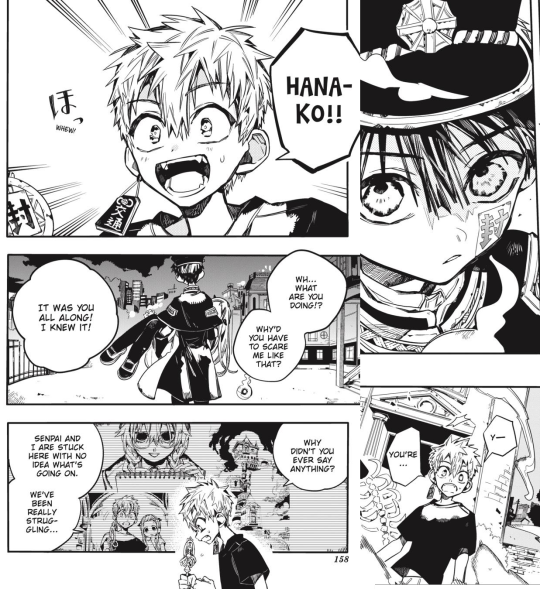
He never had a wish for Hanako to be alive, to be his classmate, so he doesn't feel any desperate attachment to the idea of 'Yugi Amane' like he did with the idea of 'Mitsuba Sousuke' only ever seeing him as a wrong version of Hanako from the start. Is not real, so of course he doesn't trust him.
His view of Hanako cannot be separated from him being a ghost.
Hanako is the one who properly introduced Kou to the world of supernaturals and served as an informant on the Far Shore when Teru kept him in the dark. He teaches Kou about rumors, boundaries, supernatural festivals, and introduces him to the complex feelings some of the dead may have about lingering on the Near Shore.
There are two main mentalities Kou has when it comes to Hanako, the first is 'I don't know enough about Hanako to tell if he is a threat, he is so weird, I want to learn about him' The second is 'he helps me and Nene. He looks after us, he is our friend.' and usually he focuses on the second.
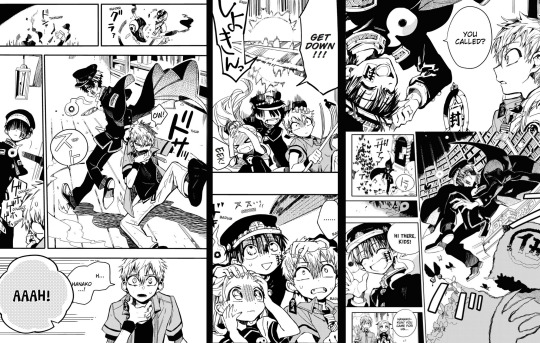
But the "i need to gauge if he is a threat" mentality is just as important as his attachment to Hanako.
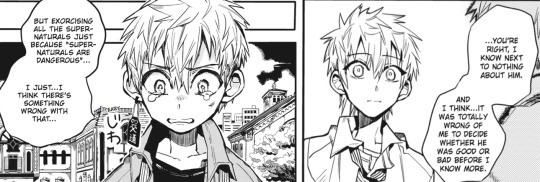
It's what makes him keep an eye on him and occasionally act like a judge, trying to figure out what is going on with him.
Hanako does a lot of good and bad things to Kou.
He sealed his exorcist staff, which debilitates him through basically the whole manga, but he helps and saves him and Nene when called, he lies and is selfish, but he seems to only lie for silly things or what Hanako seems to believe is the greater good (the eye drops, Nene's lifespan). He seems guilty and burdened by his murder but he did murder someone. He is important to Nene, he is important to Kou, and so on.
Is too much to keep track of. Too hard to give a judgment.
So he focus on his feelings way more than logic, and he is very inclined to have a positive view of Hanako. He wants Hanako to be good. To be a friend.
He does notice his slimy behavior and he does change his perception of Hanako, slowly understanding him better and growing more wary of what he says, more careful when trying to read him.
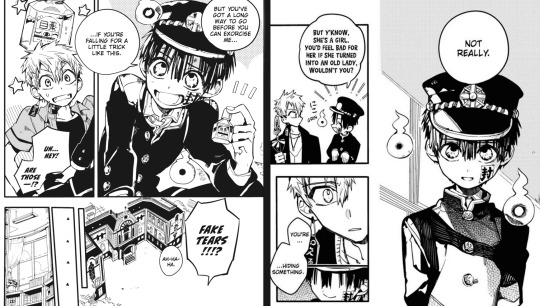
But his doubts aren't nearly as heavy as his hopes for Hanako: He believes he wants the best for them.
If we go back to the scene where Nene is talking about Amane, there is something she says that sticks with Kou, something that immediately catches his attention "Maybe I shouldn't be his friend"
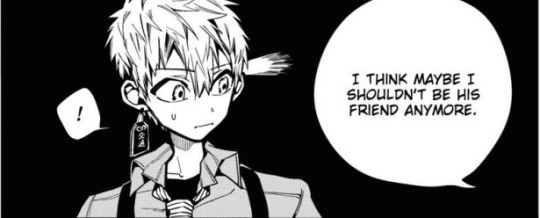
Unlike his death, this is a conflict Kou relates to.
He is making donuts for Hanako as they speak, absorbing everything he learns about the guy and using the information to help Hanako because he wants to cheer up Hanako.
Hanako being important to Nene is important to Kou. They are a group of friends to him, and he isn't alone in his uncertainty.

Kou keep this mentality of just doing what he wants for a while, childish as it is, but slowly, he is forced to give Hanako more thought, to take him seriously.
His view on Hanako has been tipping to the negative recently. He always knew about Hanako being strange and full of secrets but he can't dismiss it anymore, since the ghost started lying about big things, like trapping Nene in a fake world and exchanging Aoi's lifespan for hers without Nene's consent. Is not like his usual avoidance and silly lies, he is getting harmful.
Hanako gave Kou plenty of glimpses into his more 'inhuman' mentality. He has shown Kou a lot of hints that pratically scream "Stop trusting me kid."
It piles up.
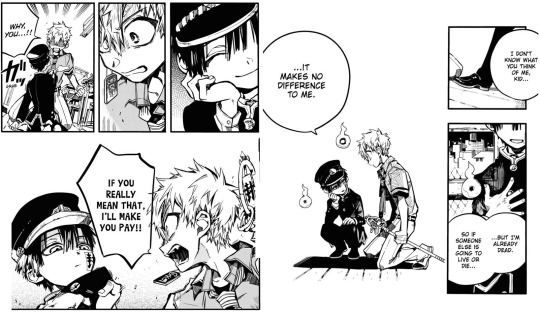

It becomes harder to know what is a lie. What isn't. What is okay and what shouldn't be forgiven.
Kou keeps trying to understand him and give him the benefit of the doubt , he truly doesn't believe Hanako is just an 'evil spirit' after everything they've been through. He is a supernatural but he is his teacher and friend too, that got to mean something.

But he doesn't have a clear answer. He can think as hard as he want, he still has no idea what is going on inside Hanako's head, he just wants to believe is something for Nene's good. Because even if he isn't sure what Hanako thinks of him, he wants to believe he wants Nene to be happy, that his care for her is strong and genuine.
Besides the conflict between "he is an apparition, he is a friend" There is also the way Kou is dependent on Hanako.
Hanako is extremely helpful, he gives him all the answers related to supernaturals. Even when Kou didn't trust Hanako, the ghost already took the role of 'the guide' in the group, offering Kou something he always wanted: Information on supernaturals. A ticket to be part of a world his brother had sheltered him from.

Hanako is this knowledgeable and reliable entity, so he always goes to him when he is in trouble.
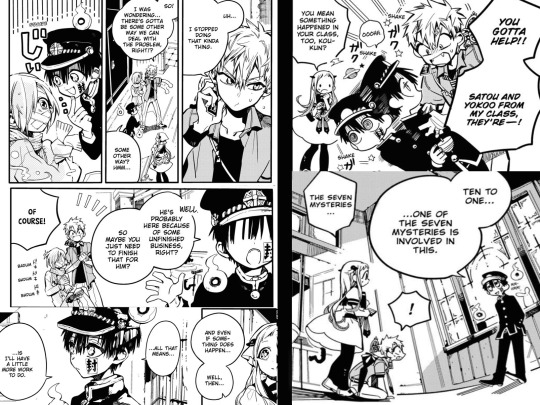
He sees Hanako as a ticked for help. Regardless of how shady he acts, Hanako always helps.
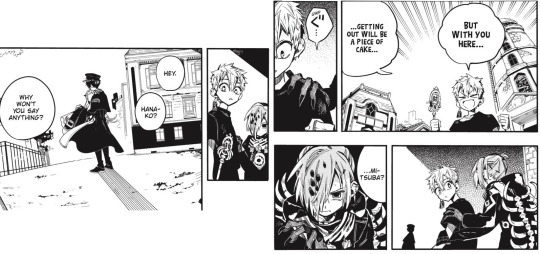
So when he tells Kou he is incompetent, it gives him a wake up call.
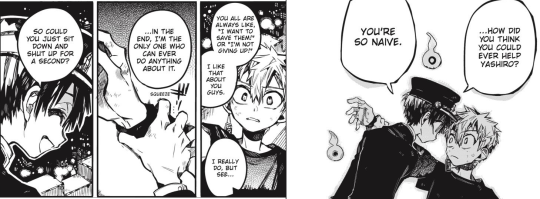
Kou always had an inferiority complex, but this puts into perspective how he relies a lot on Hanako. He doesn't solve anything by himself, he either follows Hanako's lead, or faces a dead end.
Kou has a lot to think about after that. He doesn't want to keep relying on Hanako, he wants to take action himself, to be something that doesn't follow Hanako or Teru's lead.
He focuses on the promise he made with Teru again.

This 'what do you want to do?' moment gives insight into a lot of relationships, but I'll only focus on what it says about Kou's view of Hanako here.
Kou is usually very sweet with Nene, but he is direct to the point of being cold here, he calls Hanako "The evil spirit of a murderer" as he had when he first met him all the way back in chap 3, It feels like an ultimatum. A judgment.
Hanako is dangerous, he needs to exorcise him. Part of him wants to exorcise Hanako. But he doesn't want to exorcise his teacher, his friend.
This brings me to his wish on the Red House.
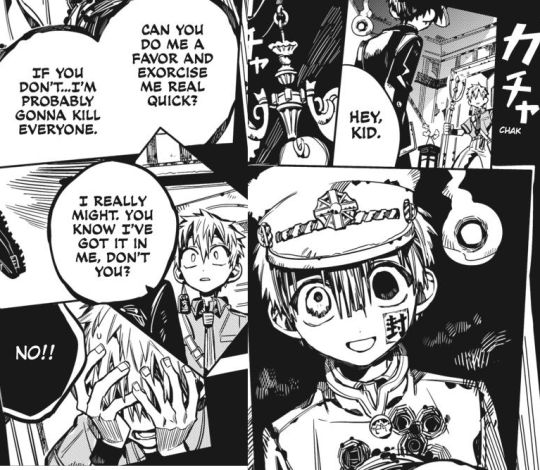
Before talking about his wish I want to point out what his wish isn’t: Kou doesn’t want Hanako’s help, advise or support. He doesn’t want Hanako to give up on trying to help nene either, so he is still depends on Hanako's actions to help Nene to some extent, he doesn't believe he can do it himself, nor does he want the pressure of being believed.
He wants Hanako to be a problem that’s easy to deal with, an evil spirit that’s undeniably evil.
Things would be much easier if Kou could exorcise him: It would prove he to himself, teru, and Hanako that he can be an exorcist, it would eliminate any possible anxiety about what Hanako will do next, and it would give Hanako what he wants, Kou wouldn't disappoint him again.
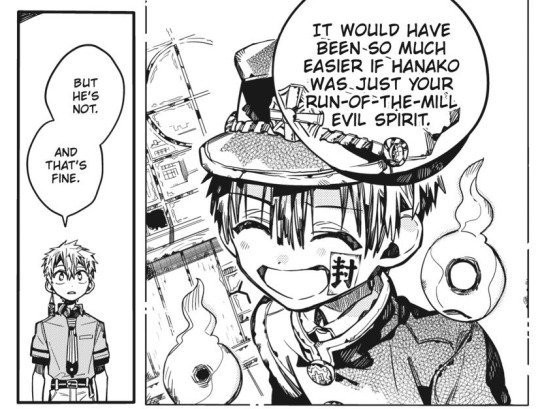
When he pictures Hanako, he is happy and sweet looking, almost innocent. He may have decided he need to exorcise Hanako at some point, that is the right thing, but he doesn't really... want him gone.
He consistently has exorcism in mind when it comes to Hanako post-severance, but he also consistently pictures him happy and friendly. .
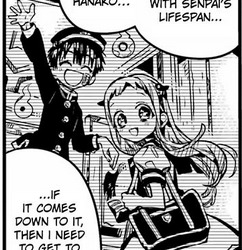
"I want to be a bigger help" implies he wants to work with Hanako, so the two help Nene instead of him being the sole person in charge of her lifespan, which is a big big difference from his self-destructive desperation to be the one to help Mitsuba.
"I need to get to the point where I can exorcise him." As it is, Kou does not believe he can exorcise him. He realizes he should, but also that he can't.
What he says when he fights Teru fits into that.

He doesn't agree with Hanako, and he denies the idea that he is doing this for Hanako, choosing to focus on his bond with Nene instead of his exorcism dilemma.
He and Nene have a simple camaraderie he can rely on, a mutual lack of understanding of what to do, but even this more 'safe' decision to be on her side instead of trying to keep discovering his own path got Kou the same reprimand Hanako had given him "You have big ideas but you can't back it up."

Both of the people he looks up to give him guidance told him he is useless. He can not fully relate to exorcists, or supernaturals, the path he is carving for himself, his beliefs, are unclear, easily shaken, and likely useless.
He still wants to be an exorcist, deep down, delighted when Teru gave him a chance. But he can't be an exorcist. Not when he thinks so much about the supernatural, unable to reject them but unable to truly understand or relate to them either.
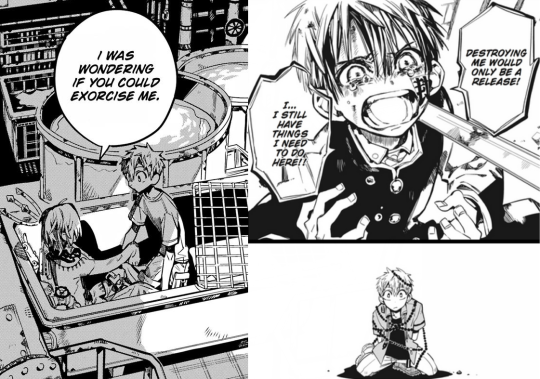
It makes me sad that Aidairo pushed Kou and Hanako's situation aside, cause they still have a lot to explore, yet all we got recently is these crumbs:

Kou is keeping his eyes on Hanako, his attitude half "I am your friend, I care about you", half "I don't trust you anymore, don't scheme again, bastard" but they don't have meaningful talks with each other anymore.
Hanako will save Kou if he sees him in danger, I'm sure. And Kou will do the same. But their trust is... shaky... and they will never talk about it. Kou won't share that he wants but can't exorcise Hanako and Hanako won't share how much he values Kou. They won't seek each other for help either. Both will slowly yet consistently focus on someone else instead, like a weirdly passive attempt at detachment.
So I have no hope for more meaningful interaction between them. Not anytime soon at least... Is truly a shame.
383 notes
·
View notes
Text
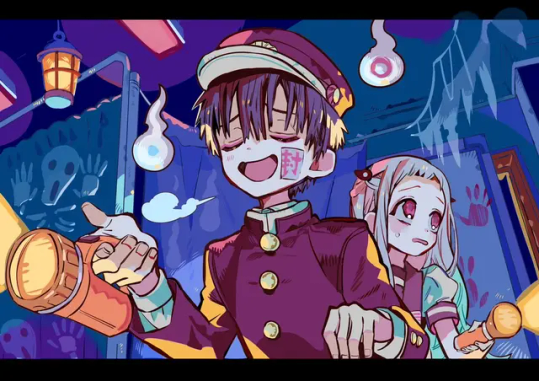
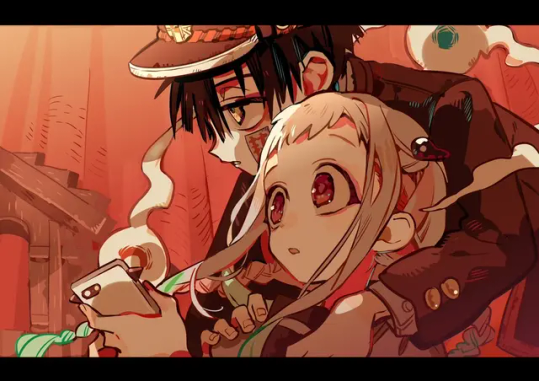
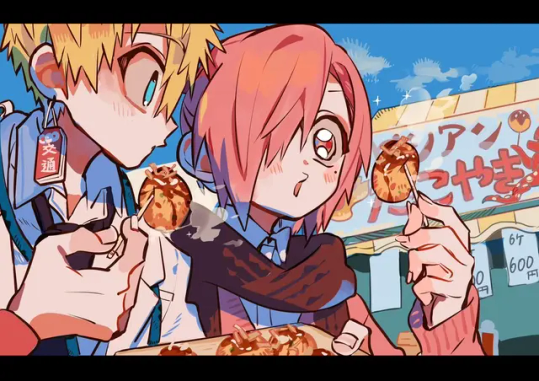
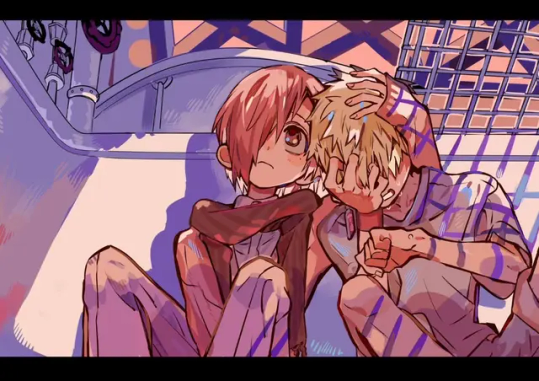

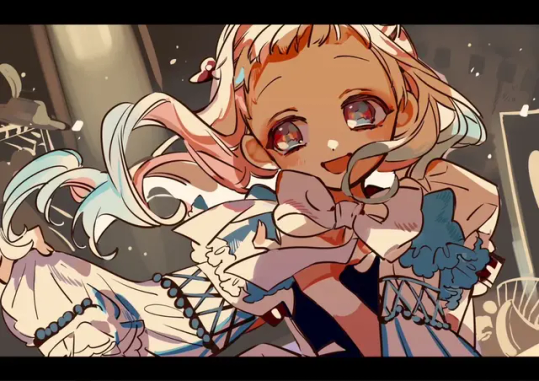
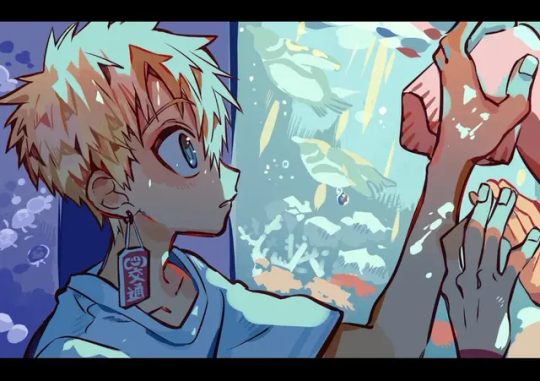
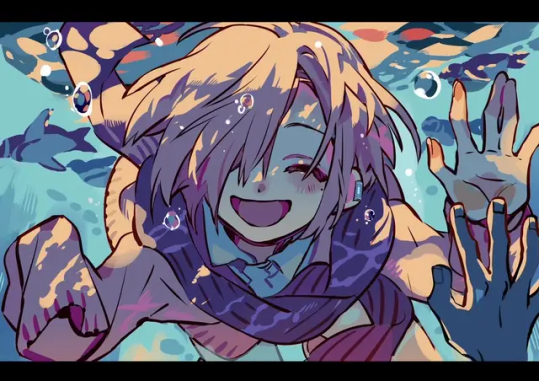
3K notes
·
View notes
Text
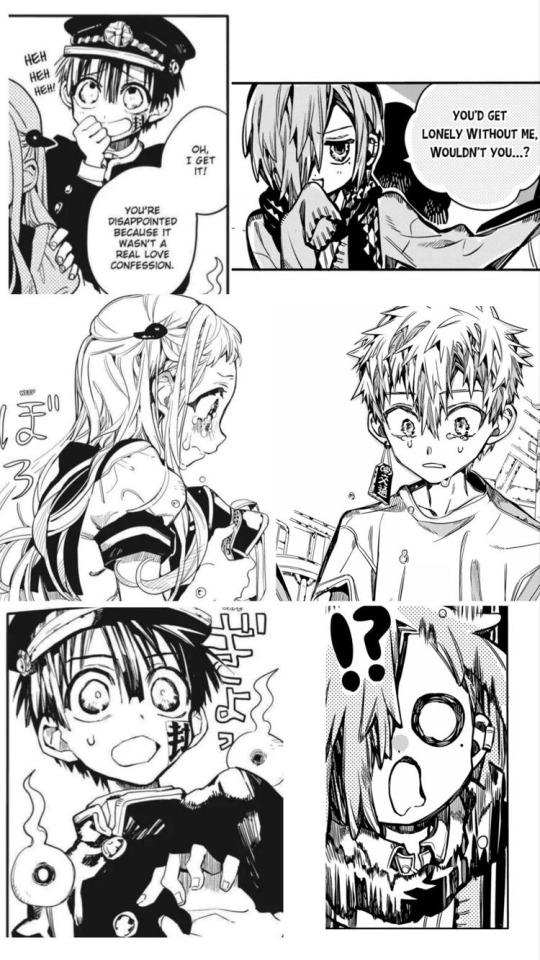
Idk smth about this is similar ….
2K notes
·
View notes
Text
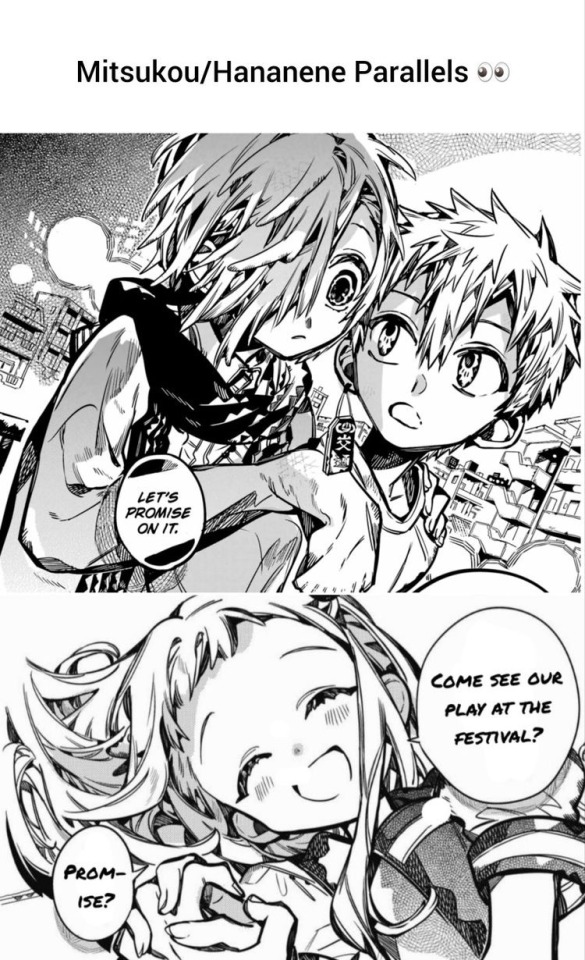
216 notes
·
View notes
Text
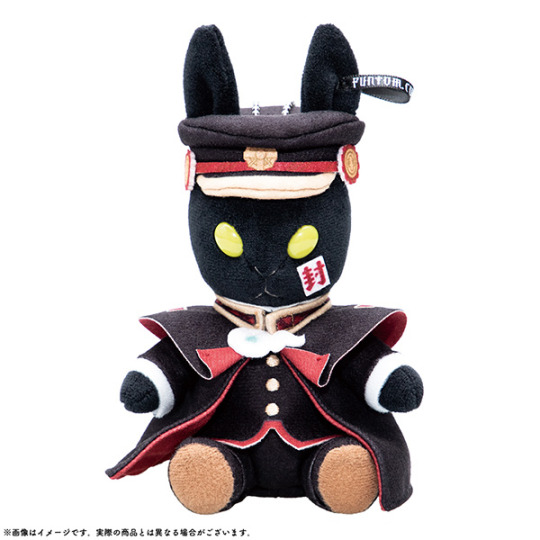
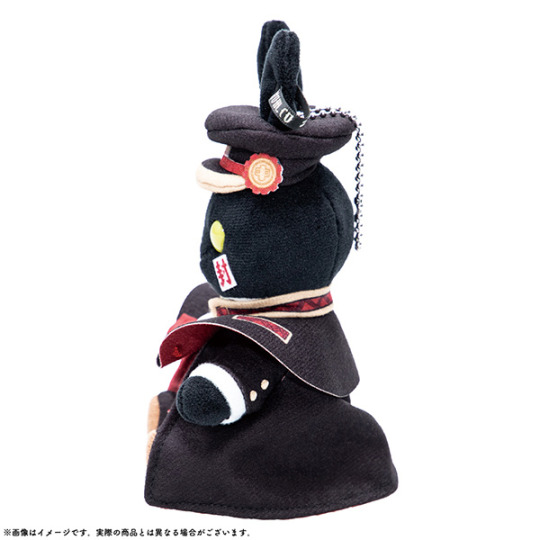
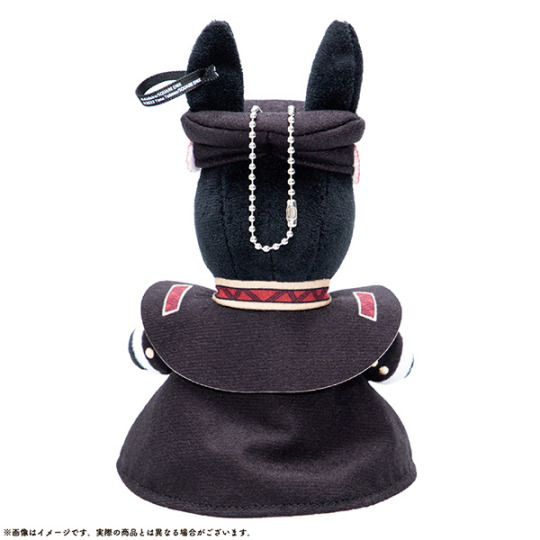
bitter rabbit hanako-kun!
115 notes
·
View notes
Text
In chapter 101, Hanako and Nene revisit an old location: The sealed auditorium!

The text explicitly mentions that this was the place where Hanako rescued Nene from the mermaid’s disciples.

A couple of very important things happened in that arc:
1.) Hanako revealed that he ended his own brother’s life.
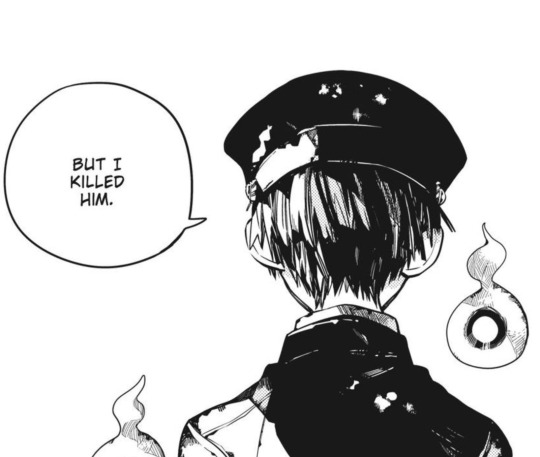
In the most recent chapter, we see Tsukasa confront Hanako as to whether or not he truly wanted him to go away. We now know that Hanako chose both. He killed Tsukasa, yes, but Tsukasa is also chained to Amane and the Near Shore because he’s his Yorishiro. I also believe 101 is the first chapter we see Tsukasa as a living teenager.
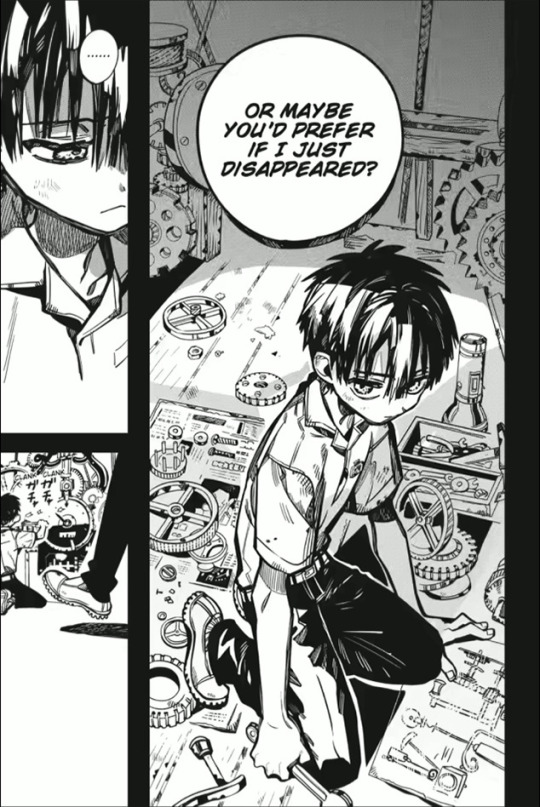
2.) Nene tried to become a supernatural.

Nene is Hanako’s assistant because of their shared connection to the Great Mermaid. It seems like the manga is alluding to a similar circumstance with Amane and the great clock. It could very well be related to the Clock Keepers, though it’s too soon to tell.
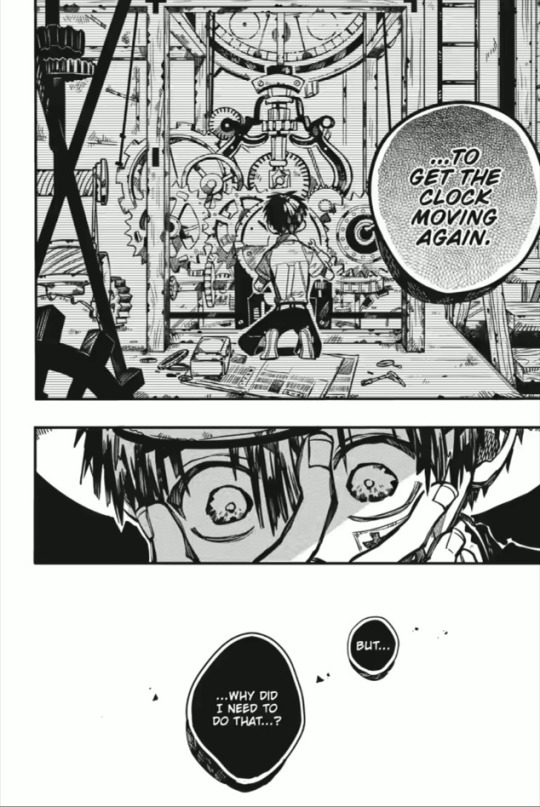
3.) Hanako vowed to tell Nene all his secrets on the steps of the auditorium.
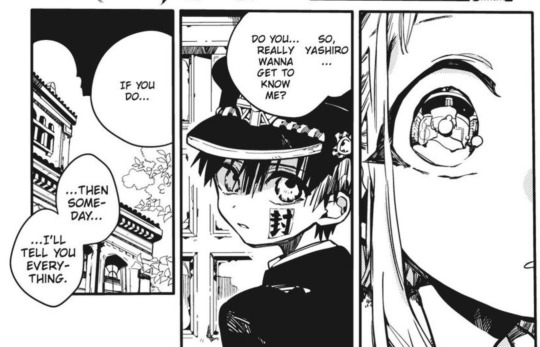
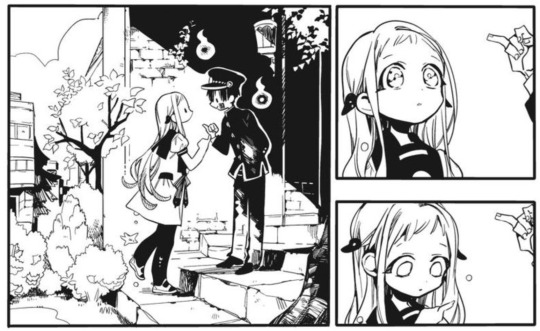
So what does it mean?
The auditorium was set up to be a very important location since the beginning of the manga, where an incredibly important bonding moment between Hanako and Nene happened.
Whatever it has to do with the plot, it’s likely setting up a large portion of Hanako and Tsukasa’s backstory and may even reveal more about the Clock Keepers.
134 notes
·
View notes
Text
okay, i know many people have already compared the two characters together.. but this chapter gave us more hair down aoi!! they look even more similar now!!


they're also both my favorite characters, i love them so much <3
66 notes
·
View notes
Text
I love how attached to Nene and Kou Hanako is, no one else can make him so worried.
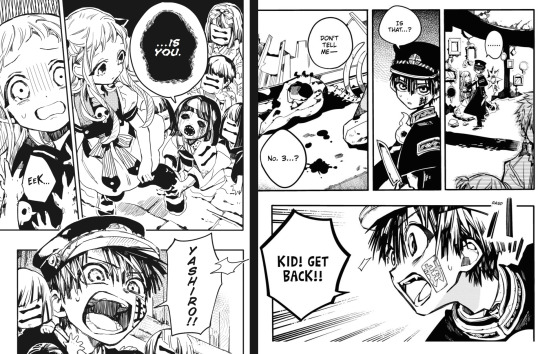
and so genuinely happy,
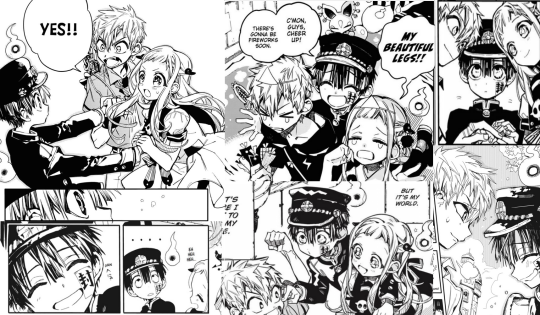
happiness from Hanako used to be so rare even Tsuchigamori, the School Mystery of knowladge, is intrigued by.


When we get insight of his mind, he always pictures Kou and Nene: They are always his focus.
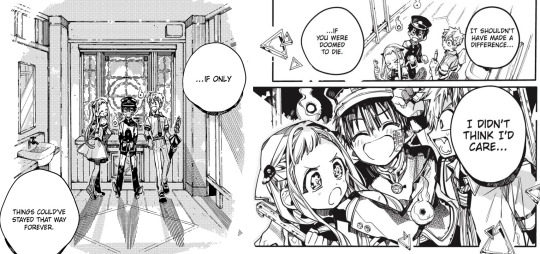
He cares about them so much it makes me go insane
885 notes
·
View notes
Text
are those hananene and mitsukou parallels i see 🤨
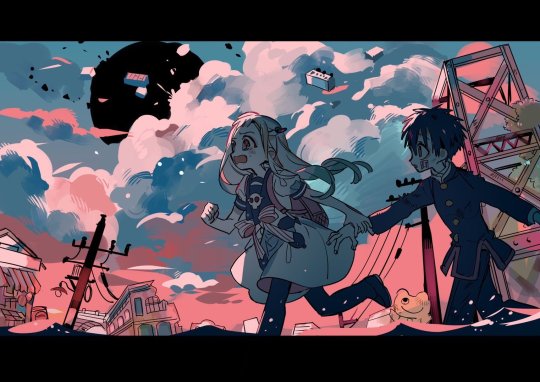
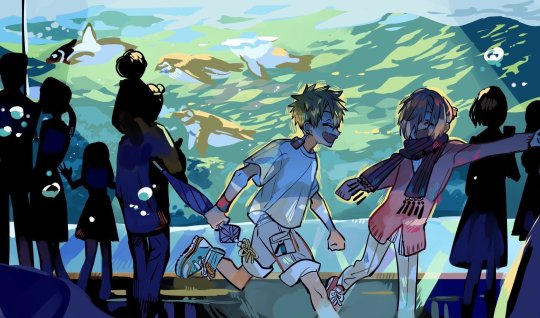
3K notes
·
View notes